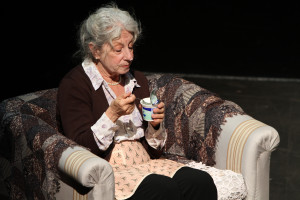In the fast paced world that we live in, it is all too easy to forget to slow down and appreciate the simplicity of a moment. “Oy!” by Hélène Cixous at The Actors’ Gang will force you to do just that. Selma and Jenny, two sisters in their late eighties, are invited by the mayor of Osnabruck, Germany, to speak with the younger generation about their childhood in Osnabruck prior to WWII. The play picks up as they return to their home in Paris, and while preparing their dinner, they sift through the emotions and memories that their trip has stirred up.
A slide show, with a beautiful underscore, starts the production and takes the audience on a trip through what look like home videos and newsreels of Germany in the 30’s and 40’s. At its conclusion the two sisters, played by Mary Eilen O’Donnell and Jeanette Horn, solemnly walk into the space, abandoning their suitcases upstage and move into the kitchen. The first line of dialogue isn’t spoken until about five to ten minutes later, and then remains sparse through to the end. Director Georges Bigot allows the pacing to be dictated by the slow actions and contemplations of the almost ninety-year-old characters.
The wonder of this piece comes from the patience of the two actresses. Nothing is rushed, and the silences are full of unspoken thoughts. Which is an ongoing theme throughout the play. The two actresses often remark that they need to say what they haven’t been saying, and then often fall back into silence. When they do speak they speak of anti-semitism, Hitler, what it was to be Jewish and bicker as only sisters can. Despite the fact that there are very few conclusions made or answers gleaned from the sisters’ discussion and an underlying frustration throughout, there are moments of levity between them. The joy of dancing to a favorite song or laughter at a mishap, reassures that despite their grim past they are alive and living today.
All of this takes place on Karyl Newman’s sparse set. The kitchen is comprised of a metal counter, with a small sink and a hot plate in lieu of a stove top. Newman’s projections splash against the flats and hung curtains lining the back wall. The playing space is utilitarian, with no added flourishes, much like the play itself. This play is esoteric. There is no big to-do, and the story comes and goes like the whisper of a sigh. My father would categorize it as “artsy-fartsy.” But to those that enjoy slowing down and reveling in the simple human moments, it is beautifully done.
*Coverage provided for the Culver City News

